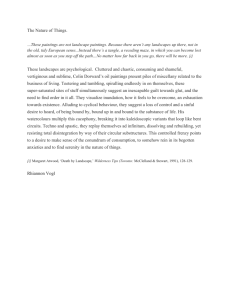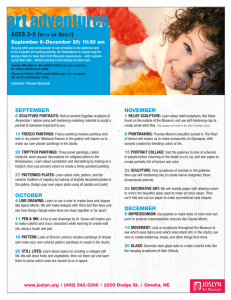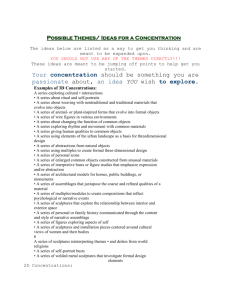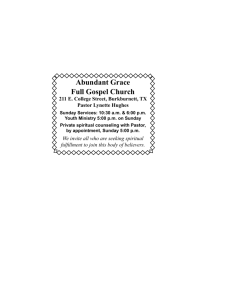Review: 'The Art Show' at the Park Avenue Armory
advertisement
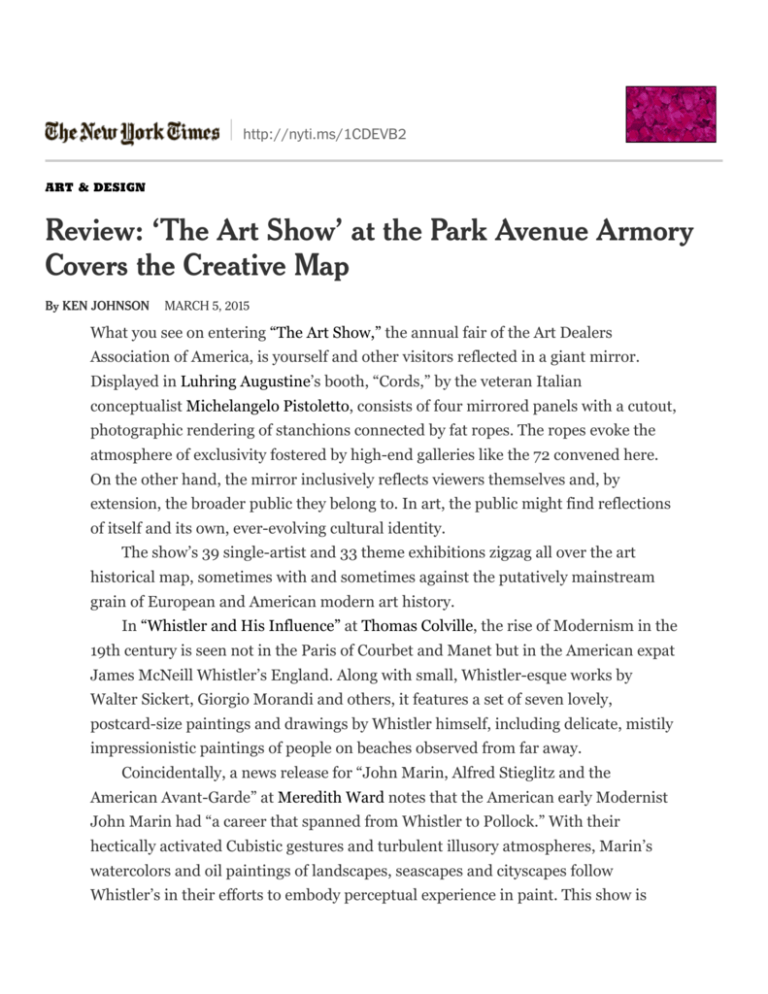
http://nyti.ms/1CDEVB2 ART & DESIGN Review: ‘The Art Show’ at the Park Avenue Armory Covers the Creative Map By KEN JOHNSON MARCH 5, 2015 What you see on entering “The Art Show,” the annual fair of the Art Dealers Association of America, is yourself and other visitors reflected in a giant mirror. Displayed in Luhring Augustine’s booth, “Cords,” by the veteran Italian conceptualist Michelangelo Pistoletto, consists of four mirrored panels with a cutout, photographic rendering of stanchions connected by fat ropes. The ropes evoke the atmosphere of exclusivity fostered by high-end galleries like the 72 convened here. On the other hand, the mirror inclusively reflects viewers themselves and, by extension, the broader public they belong to. In art, the public might find reflections of itself and its own, ever-evolving cultural identity. The show’s 39 single-artist and 33 theme exhibitions zigzag all over the art historical map, sometimes with and sometimes against the putatively mainstream grain of European and American modern art history. In “Whistler and His Influence” at Thomas Colville, the rise of Modernism in the 19th century is seen not in the Paris of Courbet and Manet but in the American expat James McNeill Whistler’s England. Along with small, Whistler-esque works by Walter Sickert, Giorgio Morandi and others, it features a set of seven lovely, postcard-size paintings and drawings by Whistler himself, including delicate, mistily impressionistic paintings of people on beaches observed from far away. Coincidentally, a news release for “John Marin, Alfred Stieglitz and the American Avant-Garde” at Meredith Ward notes that the American early Modernist John Marin had “a career that spanned from Whistler to Pollock.” With their hectically activated Cubistic gestures and turbulent illusory atmospheres, Marin’s watercolors and oil paintings of landscapes, seascapes and cityscapes follow Whistler’s in their efforts to embody perceptual experience in paint. This show is notable, too, because the works in it once belonged to Alfred Stieglitz and were returned to Marin by his widow, Georgia O’Keeffe, after Stieglitz died. Another painter in the Whistlerian tradition was Jane Freilicher (1924-2014), the subject of an inspirational solo show at Tibor de Nagy. Hanging on the booth’s main wall are two expansive, atmospheric canvases, one depicting a rural, seaside landscape in the cool light, possibly of morning and the other representing Manhattan building tops tinged red by a setting sun. The contemporary painter Maureen Gallace also can be seen as a Whistler descendant. Her small, luminously pale pictures of the ocean meeting sand (at 303 Gallery) adroitly play with tension between painterly gesture and illusory image. They have a Postmodernist spin, too, that calls attention to the formal and poetic conventions of pastoral landscape painting. Many of the show’s most impressive presentations are of works by female artists. Others on view include Joan Brown (1938-1990), whose robust, cartoonish paintings at George Adams include a delightfully goofy, life-size self-portrait of the wide-eyed artist holding a big fish in her left arm, a paint brush in her right hand. “Gordon, Joan and Rufus in Front of S.F. Opera House” (1969), a diptych over seven and a half feet wide, portrays the artist and her husband in formal wear and their dog under leafy trees growing from concrete planters with puffy clouds in the distance. David Nolan has an excellent show of drawings and paintings from the ’60s and ’70s by the Chicago Imagist Christina Ramberg (1946-1995). Ms. Ramberg’s paintings of female torsos outfitted with fetishistic undergarments or afflicted by epidermal problems are psychologically combustive, and her works on paper are fascinating. She made page after page of small, neatly drawn, comic-book style images of girdles, bustiers, high-heel shoes and bizarre headwear. They are marvelous expressions of erotic curiosity, desire and anxiety. Ree Morton (1936-1977), at Alexander and Bonin, is another offbeat example. Made as if by an untrained eccentric who has cultivated her own private language of signs and symbols, Ms. Morton’s paintings and sculptures may be hard to interpret, but they are infectiously playful. At Salon 94, Lorna Simpson injects a dose of racial and class consciousness, something otherwise not profusely represented in the show. A set of photographic images of wigs for black women printed on pieces of thick off-white felt is annotated by printed texts from books about slavery. A series of paintings apparently made by using wigs to impress images of hair in glittery gold paint suggests an equation of art, blond tresses, money and power. Jan Groover (1943-2012), the photographer of dreamy, coolly formal still lifes at Janet Borden and Etel Adnan, the nonagenarian painter of small, richly colorful, patchwork abstractions at Galerie Lelong are two more arresting shows of works by women. Male artists contribute to the pluralistic mix. David Zwirner has a solo show of works by Forrest Bess (1911-1977), the once barely known and now much acclaimed, mid-20th-century painter of small, enigmatically symbolic abstractions. At PPOW, Anton van Dalen’s stark, precisely drawn cartoon images from the late ’70s and early ’80s chronicle a time of urban decay and social unease on New York’s pre-gentrification Lower East Side. At Sperone Westwater, two of Barry X Ball’s technically amazing, machinecarved and hand-finished sculptures look back to early in the 20th century, when the future seemed tremendously promising to some avant-gardists. Both are copies of Umberto Boccioni’s immortal Futurist sculpture Unique Forms of Continuity in Space, (1913), which resembles a man in flames striding toward a heroic destiny. Mr. Ball’s sculptures — one in Belgian black marble, the other plated in mirror-bright gold — revisit a deliriously optimistic history that was blown off course by greater historical forces. What they look forward to is a history yet to be written. March Fair Season Highlights THE ART SHOW continues through Sunday at the Park Avenue Armory, Park Avenue at 67th Street; artdealers.org/the-art-show/information, 212-488-5550. THE ARMORY SHOW runs through Sunday at Piers 92 and 94, 12th Avenue, at 55th Street, Manhattan; thearmoryshow.com; 212-645-6440. INDEPENDENT 2015 runs through Sunday at 548 West 22nd Street, Chelsea; independentnewyork.com. Many other satellite exhibitions will take place during March Fair season. Here are a few recommendations: ART ON PAPER, featuring work by artists who use paper as a major influence in their sculpture, drawing, painting and photography, runs through Sunday; Pier 36, 299 South Street, Lower Manhattan; thepaperfair.com. PULSE NEW YORK, a showcase for cutting-edge contemporary art, runs through Sunday at the Metropolitan Pavilion, 125 West 18th Street, Chelsea; pulseart.com. 212-255-2327. VOLTA NY, which focuses on solo-artist projects, runs through Sunday at Pier 90, next to Piers 92 and 94, the platform for the Armory Show; ny.voltashow.com/index.php. “The Art Show” continues through Sunday at the Park Avenue Armory, Park Avenue at 67th Street; 212-488-5550, artdealers.org/the-art-show/information A version of this review appears in print on March 6, 2015, on page C28 of the New York edition with the headline: Zigzagging Across a Cultural Landscape. © 2015 The New York Times Company
